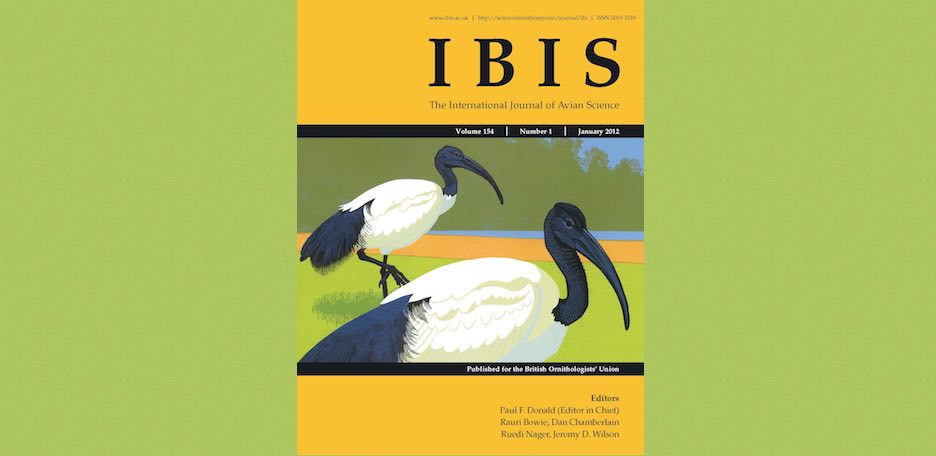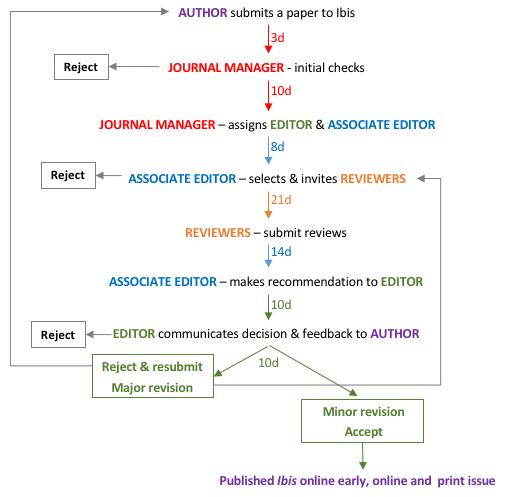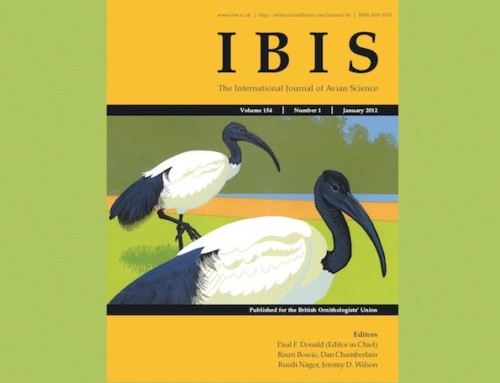VIEW – current issue | VIEW – editor’s choice | VIEW – all issues
Managing an international journal is a massive team effort, and for IBIS this involves over 60 people.
How do we manage the #1 journal in ornithology?
I am a conservation scientist with the RSPB but I also have the important role of chairing the committee which oversees the management of IBIS – the BOU’s international journal of avian science.
As an ornithologist, I read, write, review and edit scientific papers, so I am well placed to understand the motivations of many of the people we rely on to work with IBIS, so that it can continue to be a success. Having recently taken on the Chair of the IBIS Management Committee, I am now working hard to understand journal management from the top down view of our editors and publishers.
Who is the IBIS committee?
Our journal committee is made up of highly experienced individuals involved at all levels of IBIS – editorial and business. It is chaired by myself and supported by Steve Dudley (Chief Operations Officer), Graham Appleton (Treasurer) and the Journal editorial team, Angela Langford (Journal Manager), Paul Donald (Editor in Chief), our five editors, Rauri Bowie, Dan Chamberlain, Rebecca Kimball, Reudi Nager and Jerry Wilson, and a journal Associate Editor, Steve Portugal (we currently have one AE vacancy).
What does the IBIS committee do?
Our main purpose is to ensure that IBIS remains one of the top journals in ornithology. We do this by providing support and advice on every aspect of journal management, including editorial processes, production, marketing and promotion and managing our relationship with our publishers, Wiley-Blackwell.
Managing a society journal would not be possible without our “community” and this is one of the reasons why the BOU works so hard to maintain a community of active, engaged ornithologists. We are totally reliant on a whole range of people, as the paper proceeds from the lead author’s computer through to publication.
What happens to your manuscript?
When, as an author, you hit the submit button, your manuscript goes through a multi-stage process before you receive that email informing you whether the paper you have poured your heart into has been accepted for publication, or not (Fig. 1).
Figure 1. The IBIS manuscript process: the different colours represent all the different people involved at each stage and the maximum length we allow for each stage in the process.
The take-home message from this is that there are lots of steps, each step takes time and is usually reliant on at least two people to move the paper onto the next step. Many papers take much less time than detailed above, and the occasional paper takes longer, e.g. due to difficulties finding suitable reviewers. We review all of these stages annually and where ever possible we continue to drive down handling times to ensure we provide the quickest possible service to our another community, whilst retaining quality of both review and the papers we accept.
Without authors we would have no journal, so we rely on our authors to submit papers to IBIS and they do so because they want to publish their research in a high quality ornithology journal. As academics, we are all under pressure to publish our work quickly so our authors also want their paper to be published in a reasonable amount of time and for that process to be positive. This is especially the case when you are publishing your first paper as an early-career researcher (ECR) – which I can barely remember these days!
Like any other journal, it’s our author community that also acts as our reviewer community. The peer review process requires the altruism of our research community to review the papers submitted for publication. You submit papers for publication which require others to review them, so you yourself review others’ papers as part of this quid pro quo system.

As journal managers we therefore need a process that ensures quality while giving authors a positive and timely experience.
Let’s think about that time aspect. Even when each step in the process is completed on time and everyone involved works to their timescales, the paper could take around 76 days from submission to first decision, and then, depending on the decision, further time may be needed to revise the paper.
And what about the quality? A paper sent for review will likely be assessed by five people, starting with our Journal Manager, then an Associate Editor (AE) and two reviewers, before reaching one of our editors for a final decision. So, of course, that takes time. Our reviewers and AEs are unpaid volunteers who play vital roles in moving papers through the publishing process and helping the editors maintain scientific quality and they do all of that to incredibly tight timescales.
For example, AEs only have 8 days to find and invite suitable experts to review the paper, these reviewers then get 21 days to review each paper and, once reviews are received, the AE adds their own detailed assessment to those of the reviewers and makes a recommendation to the editor within 14 days. It is easy to see how timescales can slip, especially when you consider our volunteers and editors have competing demands on their time i.e. their day jobs as scientists! As a committee we are constantly trying to come up with ways to make this process a more enjoyable and efficient experience for everyone.

One of the other important roles is to work with our publishers Wiley-Blackwell to ensure that both parties get what they need from what is a business relationship. We do this through regular communication and through annual meetings, where we review the overall performance of the journal from the number of papers submitted, the number of article downloads, our top-cited papers, to activity on social media. Importantly, we also spend a lot of time looking ahead and coming up with short and long term strategies to keep IBIS at the forefront of ornithology publishing. One of my roles is to make sure we implement these strategies.
The publishing process can be tough and I think it is my job to ensure that this process is as efficient and positive as possible for authors, reviewers, AEs, editors and staff. We are constantly working with our community, editorial team and our publisher, Wiley-Blackwell, to ensure that we improve and review the way we work based on the feedback we receive.
IBIS is incredibly important to the BOU because the income it provides supports all our other activities, for example, the grants, bursaries and conference support that helps to develop the ornithologists of the future. Our journal income is largely generated from institutions paying to receive IBIS, and if they don’t like what they get they will stop paying. So we need to constantly strive to ensure we are providing our readers with what they want while also looking after our authors, AEs, reviewers, editors, staff and publishers.
So next time you submit a paper, and its taking a little longer than you hoped, spare a thought for everyone involved in the processes that ensures IBIS remains at the top of the ornithology journals for a long time to come.
VIEW – current issue | VIEW – editor’s choice | VIEW – all issues
And there’s more . . .
In coming weeks we’ll be posting blog articles explaining more about what we do and why we do it. In the meantime, read more about some of our community, about why they are BOU members and why and how they help us deliver our many activities.
More about the BOU
The BOU’s global ornithology community
What makes a BOU conference?
The BOU – a personal perspective from the US
Funding ornithology – the work of the BOU Grants Committee
Listing into the future
BOU – we’re better when we’re together
Developing early-career researchers
Meet some of our members and those who help run the BOU
Blog with #theBOUblog
If you want to write about your research in #theBOUblog, then please see here.
Images
Edited paper | Nic McPhee via Flickr
Board meeting | LiAnna CC-BY-SA-4.0 via Wikimedia Commons






